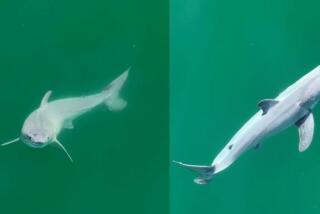Must Reads: Watch science and art in action in these award-winning microscopic videos
Sometimes there’s a fine line between science and art.
Nikon Instruments recently unveiled the winners of its annual Small World in Motion contest, a microscopic videography competition that highlights the beautiful and strange sights of an often unseen world.
This year’s top winners, Elizabeth Haynes and Jiaye “Henry” He of the University of Wisconsin-Madison, captured a time-lapse video of a zebrafish nervous system as it developed over 16 hours. The entire thing was condensed into a 40-second clip.
“When we first saw the video, it was jaw-dropping,” He and Haynes recalled in an email. “Many things have to go right to get a movie this beautiful.”
You can watch all five of the winning videos below.
1st place: A zebrafish embryo develops over 16 hours
Elizabeth Haynes and Jiaye “Henry” He, University of Wisconsin-Madison
You’re watching the creeping, crawling development of a zebrafish embryo’s nervous system. The tail extends across the screen; its head is down on the right.
Two neurons in the spinal cord are forming a sensory network to talk to the brain. They soon branch out throughout the body.
“These axons grow incredibly long distances and establish complex, beautiful architectures,” Haynes and He said.
A third neuron, the peripheral axon, slowly reaches from the head to the tail. This will allow the fish’s skin to sense touch.
The embryo is 1 millimeter in length. The smallest offshoot of a neuron is mere nanometers in diameter.
By watching how the zebrafish’s nervous system develops, the researchers hope to better understand the genes that code for a mysterious neuronal highway system, called the kinesin light chain. This system carries cargo across the cell.
Researchers have linked defects in these genes with neurodegenerative disorders such as Alzheimer’s.
2nd place: A laser light show through a film of soap
Miguel Bandres and Anatoly Patsyk, Technion–Israel Institute of Technology
This is what the shimmering rainbow of a soap bubble looks like up close.
Miguel Bandres wanted to study light behaving in “a totally unusual new way.” So he zapped a microscopic layer of soap with a laser.
The result, as he describes it, is a swirling “river flowing through a landscape of mountains.”
“So far, visually, this is the most beautiful research I have done,” Bandres said.
The soap layer is less than 1 micrometer thick (for reference, that’s about 50 times smaller than the thickness of a human hair). Slight variations in the soap membrane cause the light to bounce, deflect and spread out across the surface, creating a microscopic light show.
“I hope [viewers] can relax or meditate when they see the video,” Bandres said. “You can see the video several times, and each time you will find something new and interesting.”
3rd place: A bristle worm tries to flee the light
Rafael Martin-Ledo, Conserjeria Educacion Gobierno de Cantabria, Spain
The light of the microscope interrupts this strange translucent worm as it digests its latest meal.
The worm may look like it’s dancing, but it’s trying to escape the light by wiggling its namesake bristles and protrusions.
This is a common sight for Rafael Martin-Ledo, who studies zooplankton in Spain’s Bay of Santander. He shares his microscopic observations on his Twitter feed, @rmartinledo, and on his website.
This larval bristle worm is 2.5 millimeters long. It’s seen here under 20 and 40 magnification.
The video shows the worm’s hairlike appendages interacting with its internal organs, which Martin-Ledo noted could be a subject of future study. For now, we can just marvel at its movements, which he calls seemingly “incomprehensible.”
“At the same time,” he writes, “when we see its eyes, we can wonder who observes whom.”
4th place: A water flea gives birth
Wim van Egmond, Micropolitan Museum in Berkel en Rodenrijs, Netherlands
“A bit of pond water is enough to fill a museum,” writes photographer and artist Wim van Egmond.
Van Egmond takes “portraits” of microorganisms, such as this tiny crustacean Daphnia. He found it in a pond near his home in the Netherlands.
“I like to portray microorganisms like you would portray a person,” he writes.
The birth of a water flea, so named because the creature resembles an insect when it swims, is something everyone can relate to, he adds.
“What I hope is that the viewer becomes interested in these organisms and doesn’t see them as something grotesque or scary but as something familiar,” Van Egmond said. Microorganisms “give you a different view on life, also your own life.”
5th place: A mouse’s white blood cell ripples into action
Jia Chao Wang, National Institutes of Health in Bethesda, Md.
This white blood cell just detected danger.
When a B cell like this one recognizes threats like bacteria, viruses and dust, its cytoskeleton begins to ripple as it reorganizes itself. It’s preparing to release antibodies.
The cell itself is only about 4 or 5 micrometers in diameter. The “super-resolution” imaging technique behind this video allows researchers to see details they previously didn’t know existed, Wang said.
White blood cells don’t act alone. Usually, another kind of immune system cell grabs invading pathogens until the B cells arrive and bind to it. The intricate architecture and symmetry of the cell during this immune activation process astounded the researchers.
“This was really cool and we wanted to share it with the world so that others can appreciate just how elegantly complex a tiny cell ... can be,” Wang said.







